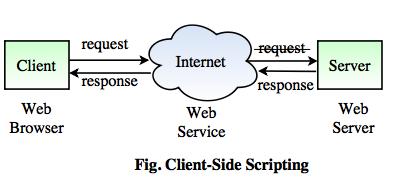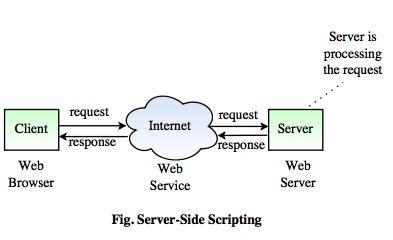Scripting concept in JavaScript
What is a script?
- Script is a small, embedded program.
- The most popular scripting languages on the web are, JavaScript or VBScript.
- HTML does not have scripting capability, you need to use <script> tag.
- The <script> tag is used to generate a script.
- The </script> tag indicates the end of the script or program.
Example : Type attribute
<script type = “text/javascript”>
document.write(“TutorialRide”);
</script>
The 'type' attribute indicates which script language you are using with the type attribute.
Example : Language attribute
<script language= “javascript”>
document.write(“TutorialRide”);
</script>
You can also specify the <script language> using the 'language' attribute.
Types of Scripts
1. Client-Side Scripting
2. Server-Side Scripting
1. Client-Side Scripting- Client-Side Scripting is an important part of the Dynamic HTML (DHTML).
- JavaScript is the main client-side scripting language for the web.
- The scripts are interpreted by the browser.
- Client-Side scripting is used to make changes in the web page after they arrive at the browser.
- It is useful for making the pages a bit more interesting and user-friendly.
- It provides useful gadgets such as calculators, clocks etc.
- It enables interaction within a web page.
- It is affected by the processing speed of the user's computer.
Operation of Client-Side Scripting
 In the above diagram,
In the above diagram,- The user requests a web page from the server.
- The server finds the page and sends it to the user.
- The page is displayed on the browser with any scripts running during or after the display.
- Client-Side scripting is used to make web page changes after they arrive at the browser.
- These scripts rely on the user's computer. If the computer is slow, then they may run slow.
- These scripts may not run at all if the browser does not understand the scripting language.
2. Server-Side Scripting- Server-Side Scripting is used in web development.
- The server-side environment runs a scripting language which is called a web server.
- Server-Side Scripting is used to provide interactive web sites.
- It is different from Client-Side Scripting where the scripts are run by viewing the web browser, usually in JavaScript.
- It is used for allowing the users to have individual accounts and providing data from databases.
- It allows a level of privacy, personalization and provision of information that is very useful.
- It includes ASP.NET and PHP.
- It does not rely on the user having specific browser or plug-in.
- It is affected by the processing speed of the host server.
Operation of Server-Side Scripting
 In the above diagram,
In the above diagram,- The client requests a web page from the server.
- The script in the page is interpreted by the server, creating or changing the page content to suit the user (client) and the passing data around.
- The page in its final form is sent to the user(client) and then cannot be changed using Server-Side Scripting.
- Server-Side Scripting tends to be used for allowing the users to have individual accounts and provides data from the databases.
- These scripts are never seen by the user.
- Server-Side script runs on the server and generate results which are sent to the user.
- Running all the scripts puts a lot of load onto a server but not on the user's system.

